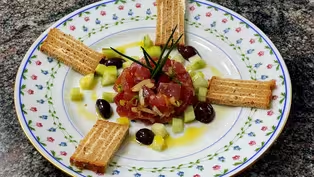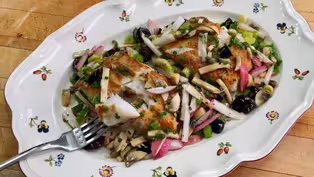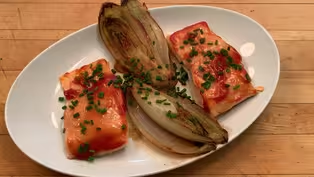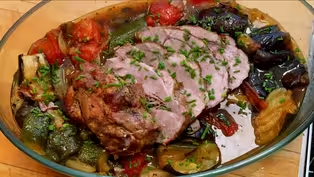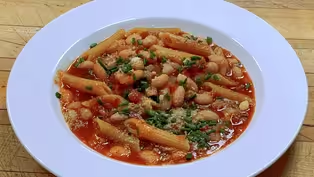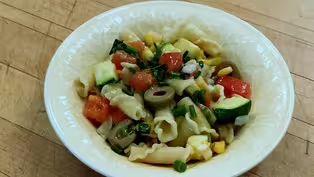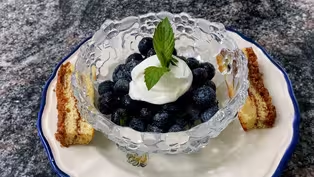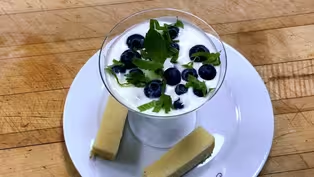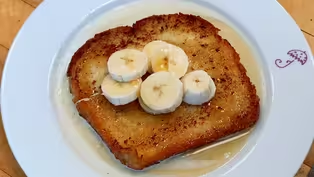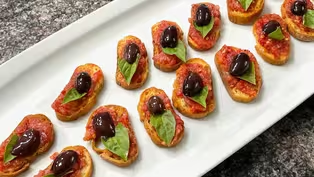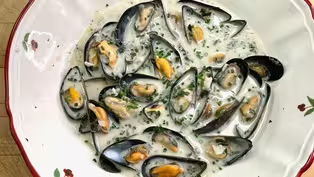
Jacques Pépin Makes Quiche Lorraine
Special | 12m 9sVideo has Closed Captions
Pépin's recipe for quiche Lorraine is inspired by his mother.
Pépin's recipe for quiche Lorraine, which is from the northeast part of France, is inspired by his mother. He also has a method for making dough that doesn't need to rest. "It's just the way my mother used to do, the quiche Lorraine in the style of Lyon."
Problems playing video? | Closed Captioning Feedback
Problems playing video? | Closed Captioning Feedback
Support for American Masters is provided by the Corporation for Public Broadcasting, AARP, Rosalind P. Walter Foundation, Judith and Burton Resnick, Blanche and Hayward Cirker Charitable Lead Annuity Trust, Koo...

Jacques Pépin Makes Quiche Lorraine
Special | 12m 9sVideo has Closed Captions
Pépin's recipe for quiche Lorraine, which is from the northeast part of France, is inspired by his mother. He also has a method for making dough that doesn't need to rest. "It's just the way my mother used to do, the quiche Lorraine in the style of Lyon."
Problems playing video? | Closed Captioning Feedback
How to Watch American Masters
American Masters is available to stream on pbs.org and the free PBS App, available on iPhone, Apple TV, Android TV, Android smartphones, Amazon Fire TV, Amazon Fire Tablet, Roku, Samsung Smart TV, and Vizio.
Buy Now

A front row seat to the creative process
How do today’s masters create their art? Each episode an artist reveals how they brought their creative work to life. Hear from artists across disciplines, like actor Joseph Gordon-Levitt, singer-songwriter Jewel, author Min Jin Lee, and more on our podcast "American Masters: Creative Spark."Providing Support for PBS.org
Learn Moreabout PBS online sponsorshipMore from This Collection
In this digital series, chef Jacques Pépin brings us into his home and teaches us many of his favorite dishes. This intimate setting is his platform for simple and instructive cooking, using inexpensive, readily available ingredients, and whatever he may have on hand.
Jacques Pépin Makes Tuna Tartare
Video has Closed Captions
Pépin serves his tuna tartare with onions, scallions and a garnish of bread and cucumbers. (6m 39s)
Jacques Pépin Makes Sautéed Cod with Mushrooms
Video has Closed Captions
Pépin serves cod with a garnish of vegetables including mushrooms, radishes and olives. (5m 44s)
Jacques Pépin Makes Baked Salmon with Sautéed Endive
Video has Closed Captions
Pépin shares his method for a simple baked salmon served with caramelized endive. (4m 2s)
Jacques Pépin Makes Pork Roast with Ratatouille
Video has Closed Captions
Pépin slow roasts this dish for a tender and juicy pork. (5m 25s)
Jacques Pépin Makes Pasta Fagioli
Video has Closed Captions
Pasta fagioli, or "pasta and beans," is a filling dish with pantry friendly ingredients. (4m 28s)
Jacques Pépin Makes Pasta Primavera
Video has Closed Captions
This versatile pasta recipe can be made with any seasonal vegetables. (5m 32s)
Jacques Pépin Makes Spaghetti with Basil Pesto
Video has Closed Captions
In the summer, Pépin likes to use fresh basil from his garden to make this pesto recipe. (8m 9s)
Jacques Pépin Prepares Blueberries with Lemon and Mint
Video has Closed Captions
Another take on blueberries, lemon and mint from Jacques Pépin. (3m 24s)
Jacques Pépin Makes Lemon Posset for Dessert
Video has Closed Captions
This lemon posset is one of Jacques Pépin's simplest recipes. (4m 16s)
Jacques Pépin Makes Ice Cream French Toast
Video has Closed Captions
Jacques Pépin adapted this recipe from his time as a breakfast cook in Paris. (3m 33s)
Jacques Pépin Makes Tomato Toasts
Video has Closed Captions
This recipe for tomato toasts with olives is inspired by Pépin's time in Spain. (6m 41s)
Jacques Pépin Makes Moules Two Ways
Video has Closed Captions
Pépin demonstrates two ways of making mussels. (5m 22s)
Providing Support for PBS.org
Learn Moreabout PBS online sponsorship(bright music) - Hi, I'm Jacques Pépin, and this is "American Masters: At Home."
(bright music) Today I'm going to show you how to make a quiche Lorraine, which is from the northeast part of France, very classic with the dough, with bacon, sometimes with ham and cheese, and so forth.
To start with the dough, I have a stick of butter here and it's cold, it's not frozen, but it's cold.
And I will cut it into pieces like this.
And I add flour.
The way you take your flour is important also, I always grab the flour and level it off like that.
And when you do it this way, three cups is a pound of flour.
You know, it's different than when you sift it.
I'm going to do it in the food processor, you know, which is easy.
So I have a cup and a half of flour.
So I'm putting in there.
Okay.
My stick of butter.
A little dash of salt, a little dash of sugar, and we start this way by pulsating here.
Okay, pulse.
As you can see, it was done very, very fast.
Oh, maybe one more.
I still want the butter to be in tiny pieces here.
And the water here, I have about, cold water again, I have about a quarter of a cup of water.
We'll see if we need a little more, sometimes your flour is drier than some other times.
Just until it takes, maybe a little more.
Maybe a third of a cup.
Okay.
I can see that it is still separated, but it's getting together, as you can see.
Now I can gather the dough together like this, as you can see.
Now, conventionally, in most recipes they tell you when you do a dough to let it rest for an hour or half an hour or so to relax the gluten, that is the protein in the flour, otherwise it's too elastic to roll.
Not if you do it this way, you can roll it right away, which is what I'm going to do.
When you do bread, for example, then you knead the dough a long time.
You get very elastic.
You have to let it rest.
But not here.
So, as you can see here, my dough.
I have a little bit of extra flour there, of course.
I'm gonna start rolling the dough this, with a rolling pin here.
Okay.
You want to have it less than a quarter of an inch thick, certainly.
It rolled very well.
And I don't know if you can see here, there is all those yellow parts, which is the butter, you know, and that's important because when the butter is like this still in tiny pieces like that, it melts in the dough and create a bit of the effect that you get in a puffed pastry, that is flakiness.
So the dough is pretty rolled, pretty much here, and I use it right away.
The best way is to roll it back on your rolling pin and place it on your, I have a removable bottom here, type of a quiche pan.
You can do it with, or without the bottom.
I'm putting it here.
Okay.
There is all right, a bit of extra dough.
Of course, and then you ease it in.
You want to ease it in.
Gently.
In that case here we are going to pre-cook the dough.
Sometimes you do it, sometimes you don't.
It's a little more delicate when you do it.
And then now to get a thicker edge, I will bring a little bit of the dough inside like this, with my thumb and cut it like this.
Yeah.
Okay, so I have brought it all over, as you can see, there is a bit less dough here, so I put a little more here and then now I can roll it this way, this way, to remove a little bit of extra dough that I had, I can cook it next to it, to do a little tart.
And now with this, I bring that this way to do a nice border.
So this is a classic way of doing the dough, whether it's for a quiche, or an apple tart, or any other type of a dough, or apple pie.
So I could leave the edge this way.
I could press it with my finger this way to do an edge like this, which is fine too.
I have that little contraption here to do an edge.
If you want this way, press it like this.
It's a little different.
Or you can leave it as is, it's perfectly fine.
Now, if you want to bake it this way, that is pre-bake it, we usually put a piece of paper in it and, and some weights, like rice or something like this.
With the aluminum foil, you don't really have to, it's a bit thicker.
So I'm going to fold it this way in four.
And then you do a, you know, a kind of a triangle like this, and you measure from the center here and the way it goes up to cut this here, to do a round shape.
And I want to put it in there now.
Press it a little bit in there so that it hold the dough in place when it's cooking.
Sometimes I even put two, like this, to make it a bit thicker.
Now, as I said, like my mother would do a quiche Lorraine like that, she never pre-cooked the dough, just put it and it's perfectly fine.
Perfectly fine.
A bit less delicate maybe than this.
And that goes into the oven.
We're to cook that for 30 minutes to start with at 400 degrees.
And the inside of the dough, we have bacon, grated Swiss cheese.
Usually I do the bacon this way, I put it on the, on napkin like this, paper napkin and I put it in the microwave oven.
Depend on your microwave oven, I'll start with three minutes.
I'm going to have three eggs for that.
And I have, we used to break the egg, like this.
You know, as I said, you always break it on something flat like this instead of something like that, so you don't bring the shell inside.
But when I was an apprentice, we used to put the eggs together and clean the inside with our finger, we didn't lose anything.
Okay, about half a teaspoon of salt about the same thing of pepper, and I'm going to beat that up.
Remember my quiche here is about nine and a half, nine, nine and a half in diameter.
So, you know, you want to beat your egg so you don't have any long string of white coming out.
And then I'm putting half and half here.
Maybe I'll put two cups.
I'll see, I may have a bit too much here.
Okay, so that's the base.
Maybe I put a bit of chives in theres just for color.
My bacon here, I put it for three minutes and I put it on another minute after.
It's nice and crisp, as you can see, and the fat, most of the fat is absorb in the paper.
So cutting into pieces like this.
That's it.
And there is my dough, the dough, and I've been cooking for 30 minutes.
I remove, and as you can see the dough now shrank a little bit, but it's partially cooked.
Sometimes people put it back in the oven to brown the center.
So here, I'm going to have my bacon, Swiss cheese, a cup will be enough.
And then my liquid in there.
I like to put some of it when it's in the oven because I'm afraid, I put it half way like this, I put it into the oven and I pour it in the oven.
If I put it too full there, I may have a mistake.
Okay.
Here is the quiche out of the oven.
As you can see, you shake it a little bit, it's holding.
It's cooked.
It's puffy.
It's going to go down slightly when it's cooled off and then you can lift it up out of the thing and cut it.
Okay, now I'm ready to serve my quiche, it's still hot, but it's not too hot.
What you want to do is to maybe bring that up under this, to get that thing out.
Wow, still hot.
And then I can cut it, Right, that would be eight for me, but oh, six.
Maybe.
Whoop.
It's just the way my mother used to do, the quiche Lorraine in the style of Lyon.
Happy cooking.
(bright music) Thank you for joining me.
For more, subscribe to this channel, or watch here.
Thank you.
And happy cooking.
(bright music)
Support for PBS provided by:
Support for American Masters is provided by the Corporation for Public Broadcasting, AARP, Rosalind P. Walter Foundation, Judith and Burton Resnick, Blanche and Hayward Cirker Charitable Lead Annuity Trust, Koo...

